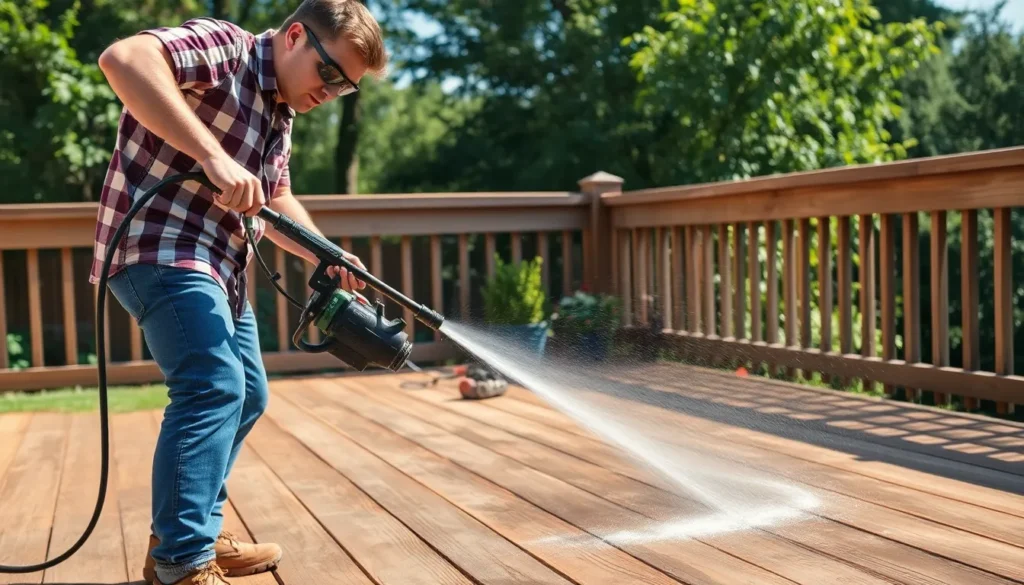Table of Contents
ToggleDecks are the unsung heroes of outdoor living, offering a perfect spot for barbecues, sunbathing, and maybe even a little dance party when no one’s watching. But over time, they can turn from a shimmering oasis into a grungy disaster zone, complete with mysterious stains and a healthy layer of grime. Enter pressure washing—the superhero of deck maintenance, ready to save the day with a blast of high-powered water.
Understanding Pressure Washing Decks
Pressure washing involves using high-pressure water jets to clean surfaces, making it a popular method for maintaining outdoor spaces. This technique effectively removes dirt, grime, and old finishes from decks, ensuring a clean canvas for any maintenance or upgrades.
What Is Pressure Washing?
Pressure washing utilizes specialized equipment that sprays water at variable pressures. The pressure typically ranges from 1,500 to 3,000 psi, depending on the surface being cleaned. This method not only eliminates dirt but also eradicates mold, mildew, and stains from wood or composite materials. Homeowners often rely on electric or gas-powered pressure washers to tackle various cleaning projects.
Benefits of Pressure Washing Decks
Pressure washing offers significant advantages for deck maintenance. Firstly, it rejuvenates the appearance of decks, enhancing their aesthetic appeal. Secondly, this method improves safety by removing slippery substances that can cause accidents. Thirdly, regular pressure washing extends the life of decking materials by preventing rot and decay. Lastly, homeowners notice an increase in property value due to well-maintained outdoor spaces.
Choosing the Right Equipment

Selecting the appropriate equipment is crucial for effective pressure washing of decks. The right tools ensure optimal results and enhance the longevity of the deck’s surfaces.
Types of Pressure Washers
Gas pressure washers deliver higher pressure levels, often exceeding 3,000 psi. Electric models, ranging between 1,500 and 2,000 psi, offer convenience and are suitable for lighter cleaning tasks. Cold water pressure washers handle most deck cleaning, while hot water models tackle tough grease stains. Users must consider their specific cleaning needs before making a choice.
Essential Accessories for Deck Washing
Using a surface cleaner attachment speeds up the cleaning process significantly. A detergent tank adds convenience by enabling easier application of cleaning solutions. A variable spray nozzle allows users to adjust the water pressure, protecting delicate surfaces. Safety goggles protect the eyes, while sturdy footwear ensures stability during cleaning. Each accessory contributes to a more efficient and effective washing experience.
Preparing Your Deck for Pressure Washing
Preparing a deck for pressure washing involves a few important steps to ensure effective cleaning and safety. Taking the time to properly prepare sets the stage for achieving optimal results.
Safety Precautions
Safety is paramount when pressure washing a deck. Wearing safety goggles protects eyes from debris, while sturdy footwear provides grip on wet surfaces. It’s wise to check the area for any loose boards or protruding nails to avoid accidents. Moving furniture, planters, and any decorations clears the deck. Covering nearby plants and electrical fixtures with tarps prevents damage from water or cleaning solutions. Lastly, ensuring the pressure washer is in good condition and using the right nozzle will minimize the risk of injury.
Cleaning Solutions and Detergents
Selecting the right cleaning solutions enhances the effectiveness of pressure washing. Detergents specifically designed for outdoor surfaces break down dirt and grime, improving overall results. For wooden decks, a gentle, biodegradable cleaner is essential to avoid harming the wood. Composite materials benefit from cleaners formulated to eliminate mold and mildew without causing deterioration. Mixing the detergent with water according to the manufacturer’s instructions ensures safe use. Applying the cleaning solution before pressure washing allows it to penetrate the surface, making the cleaning process more efficient.
The Pressure Washing Process
Pressure washing a deck involves a systematic approach to achieve optimal results. Following a step-by-step guide ensures thorough cleaning and maintenance.
Step-by-Step Guide to Pressure Washing Decks
- Gather the necessary equipment such as a pressure washer, cleaning solutions, surface cleaner attachments, safety goggles, and sturdy footwear.
- Clear the deck completely, removing furniture and obstacles to access all surfaces.
- Inspect the deck for loose boards or hazards, addressing any issues before starting.
- Mix a biodegradable cleaner suitable for wood or a specialized formula for composite materials.
- Apply the cleaning solution to the deck, allowing it to sit for a few minutes to loosen dirt and grime.
- Adjust the pressure washer to an appropriate setting, typically between 1,500 and 2,500 psi for wood.
- Begin washing from one end of the deck to the other, using sweeping motions to cover the entire surface.
- Rinse thoroughly, ensuring no soap residue remains, which can affect the finish.
Common Mistakes to Avoid
Avoiding common mistakes prevents damage during pressure washing.
Using too high of a pressure setting can cause wood splintering or damage to finish. Additionally, neglecting to check for loose boards leads to problems during cleaning. Omitting safety gear such as goggles exposes individuals to potential hazards. Skipping the application of cleaning solutions results in subpar cleaning outcomes. Rushing through the process without allowing cleaning solutions time to work diminishes effectiveness. Lastly, failing to properly rinse leaves behind detergent residue, which can attract dirt over time.
Maintenance After Pressure Washing
After pressure washing a deck, maintaining its condition becomes essential. Taking specific steps ensures longevity and enhances appearance.
Protecting Your Deck
Applying a protective sealant after washing safeguards the wood. Sealants create a barrier against moisture, preventing rot and decay. Regular inspections should follow to check for signs of wear. Additionally, UV protectants shield the surface from sun damage, preserving color and texture. Scheduling cleanings every year helps maintain clarity and avoid build-up. Using mats or rugs in high-traffic areas minimizes scratches and wear. Deck furniture can be moved frequently to prevent uneven fading. Regular maintenance allows enjoyment without extensive repairs later on.
Recommended Products for Deck Care
Utilizing quality products bolsters deck longevity. Water-based sealants typically offer excellent protection without harmful chemicals. Biodegradable cleaners provide a safe option for regular washing, especially for wood decks. Composite deck cleaners target specific materials, ensuring optimal results. Additionally, UV protectants extend the life of finishes and colors. A soft-bristle brush enhances cleaning efficiency, especially in hard-to-reach areas. Selecting the right products not only ensures cleanliness but also promotes a beautiful outdoor space. Consistency in using recommended products yields the best long-term results.
Pressure washing decks is a vital step in maintaining their beauty and functionality. By effectively removing dirt and stains it not only rejuvenates the deck but also enhances safety and longevity. Regular pressure washing helps prevent issues like rot and decay while boosting property value.
Investing in the right equipment and following safety precautions ensures a successful cleaning process. With proper maintenance including the application of sealants and regular inspections, decks can remain a cherished part of outdoor living for years to come. Embracing these practices will lead to a stunning and durable outdoor space that invites relaxation and enjoyment.




